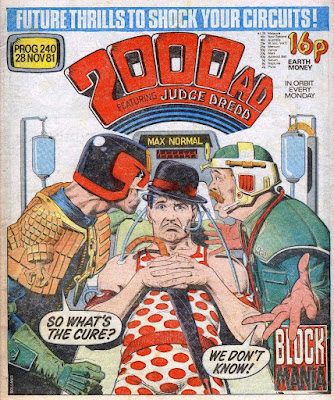Judge Dredd: The Apocalypse War
IDW, April 2014


'Judge Dredd: The Apocalypse War' (231 pp., IDW, April 2014) is a high-quality graphic novel from the 'Judge Dredd Classics' imprint, which compiles past issues of the character's appearances in the early years of 2000 AD comics from the UK.
If you ask any American comic book fan what he or she regards as the best comic book series or storyline in the early 1980s, they most likely will tell you it's the 'Dark Phoenix' saga from The X-Men issues 129 - 138 (January- October 1980). There was much turmoil and angst both in the Marvel editorial offices and in fandom when Dark Phoenix, aka Jean Gray, casually wiped out the entire population of aliens ('asparagus people').
The 'Dark Phoenix' saga was as overwrought and humorless as anything in American comics, before or since.
But over in the UK, in October 1981, a series that was markedly superior, one that can rightfully be called one of the best of the decade, was launched in the pages of the weekly comic book 2000 AD. This was the epic Judge Dredd adventure 'The Apocalypse War'.

The problem was, no one in the USA besides those few people who followed UK comics had any idea of what was going on within the pages of 2000 AD. There was no internet in those days, no digital comics, and only a smattering of UK books made the transatlantic journey to the racks of the few American comic book shops that stocked British publications.
This compilation from IDW compiles all the episodes from 'Block Mania' (the prequel to the Apocalypse War) and 'The Apocalypse War'. The original black-and-white comics have been reproduced in a higher resolution, and colored.
Without disclosing too many spoilers - and certainly no major ones, here's a synopsis:
Without warning, there is a drastic rise in inter-block aggression in Mega City One. The slightest insults trigger homicidal assaults from the thousands of residents of one block upon another. The cause is unknown, but as the body count rockets, the resources of the Judges are increasingly inadequate to maintain law and order.
It's up to Judge Dredd to try and discover the cause of Block Mania - before Mega City One becomes a gigantic insane asylum.....
The writing for 'Block Mania' was done by Alan Grant (using the pseudonym T. B. Grover), who does a very good job of seeing that each episode ratchets up the mayhem and anarchy gripping the city, and the helplessness of the Judges to restore any sort of order. These episodes avoid the emoting that would have been heavily applied in an American comic, in favor of healthy doses of violence, mayhem, and black humor that had me laughing out loud at regular intervals.
The artwork, by 2000 AD stalwarts Mike McMahon, Brian Bolland, Ron Smith, and Steve Dillon, is all top-notch and effective (despite the habit of British comics of eschewing sound effects). Given that 2000 AD were printed directly onto cheap newsprint-grade paper, the reproductions in this IDW compilation show how good the original artwork really was:
With issue 245 of 2000 AD (January 1982) the 'Apocalypse War' story proper began.
Alan Grant again handled the scripting duties, along with contributions from John Wagner.
In the opening chapters of 'Apocalypse', the Russians - represented by the East Meg One megacity - launch a nuke strike on Mega City One. Grant's writing takes a kind of fiendish glee with amping up the nuclear devastation and the concomitant body count, an attitude that- needless to say - never would have passed an editorial review by Jim Shooter at Marvel comics......
No sooner has the destruction ended then the Russians deploy their army and endeavor to capture Mega City One and, by extension, most of the eastern seaboard of the USA. It's up to Dredd and a ragtag group of surviving Judges to resist the onslaught.
In these later episodes, Grant's scripting adopts a gleeful mingling of satiric, laugh-out-loud humor and violent action.
Not only is there an outbreak of 'Apocalypse Fever'.....
......but Judge Dredd's lisping robot Walter, and Dredd's landlord Maria (who talks in Italian-accented English), get in on the action, too.........
And Dredd has no qualms about dealing roughly with Mega City One citizens who side with the Commies.......can you imagine any American comic book hero in the early 80s displaying this kind of ruthlessness ? The Punisher was still several years in the future....
The concluding chapters of 'The Apocalypse War' get genuinely suspenseful as Dredd leads a 'suicide squad' of Judges in a desperate attempt to retaliate against the Russians...
The depictions of a nuclear strike, a nuclear winter, and combat amid the ruins of Mega City One all were patently 'transgressive' by the standards of American comics and American Pop Culture in the early 80s. This was, after all, the era of increasing alarm over the Cold War and the likelihood of a deliberate (or unintentional) nuclear exchange.
Jonathan Schell's book about the effects of a nuclear war, 'The Fate of the Earth', was a New York Times bestseller in 1982, and the subject of considerable angst in highbrow circles....
And also in 1982, the Fixx were on MTV singing their single 'Red Skies at Night'.....
By turning WW3 into an over-the-top action fest rather than a sober exposition on The Fate of the Earth, Alan Grant and the 2000 AD crew pretty much thumb their noses at these pop culture expressions of angst. They certainly didn't subscribe to the 'shared humanity' ethos that dominated the pop culture's treatment of a future conflict with the Soviets. Indeed, Grant depicts the Russian leaders as homicidal psychopaths devoid of morals:
Summing up, whether you're a fan of Judge Dredd, UK comics of the 80s, or someone who simply likes a good read, 'Judge Dredd: The Apocalypse War' is well worth picking up.
















































































